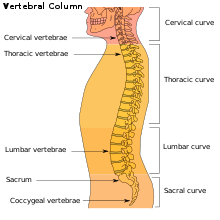| Cervical spinal stenosis | |
|---|---|
 | |
| A human vertebral column | |
| Specialty | Orthopedic |
Cervical spinal stenosis is a bone disease involving the narrowing of the spinal canal at the level of the neck. It is frequently due to chronic degeneration,[1] but may also be congenital. Treatment is frequently surgical.[1]
Cervical spinal stenosis is one of the most common forms of spinal stenosis, along with lumbar spinal stenosis (which occurs at the level of the lower back instead of the neck). Thoracic spinal stenosis, at the level of the mid-back, is much less common.[2] Cervical spinal stenosis can be far more dangerous by compressing the spinal cord. Cervical canal stenosis may lead to serious symptoms such as major body weakness and paralysis. Such severe spinal stenosis symptoms are virtually absent in lumbar stenosis, however, as the spinal cord terminates at the top end of the adult lumbar spine, with only nerve roots (cauda equina) continuing further down.[3]